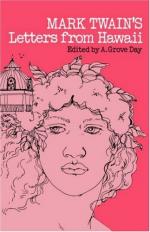
|
| Name: _________________________ | Period: ___________________ |
This test consists of 15 multiple choice questions and 5 short answer questions.
Multiple Choice Questions
1. Where was Twain observing the lovely scenery at the beginning of chapter 11?
(a) Hanauma Bay.
(b) Coconut Island.
(c) Kaena Point.
(d) Nuuanu Valley.
2. Which one of the following is an example of Twain's uncooperative horse's actions in chapter 6?
(a) The horse would only ride in the wrong direction.
(b) The horse ate too much.
(c) The horse would not move.
(d) The horse fell asleep.
3. According to Twain's observation, what was Minister Harris's platform built on?
(a) Neither showmanship nor pretense.
(b) Showmanship and pretense.
(c) Pretense with no showmanship.
(d) Showmanship with no pretense.
4. Which Hawaiian islands were sighted first by Twain in chapter 4?
(a) Maui and Molokai.
(b) Oahu and Molokai.
(c) Lanai and Kauai.
(d) Oahu and Maui.
5. What did Twain think the bones were from at the burial site in chapter 7?
(a) Tourists.
(b) Plague victims.
(c) A battleground.
(d) He did not know.
6. What differences in Honolulu and San Francisco did Twain observe in chapter 4?
(a) Fragrant plants, culture, and unpredictable weather.
(b) Fragrant plants and unpredictable weather.
(c) Unpredictable weather and culture.
(d) Fragrant plants and culture.
7. What caused Twain to marvel at Hawaii's state in chapter 6?
(a) Hawaii's barbaric past.
(b) A river.
(c) A statue.
(d) Hawaii's people.
8. Which name was given to the pig aboard the steamer that was eventually converted into pork chops?
(a) Dennis.
(b) Porky.
(c) Larry.
(d) Bob.
9. What did Twain write about the Hawaiian horse traders in chapter 6?
(a) They sold good horses and were reasonable.
(b) They were dishonest and sold poor horses.
(c) They were dishonest, but sold good horses.
(d) They sold poor horses, but were reasonable.
10. What did Twain say was jumbled together in the Hawaiian legislature?
(a) Only resolutions and the reading of bills.
(b) Motions, resolutions, notices, and the introduction and reading of bills.
(c) Only motions, notices, and the introduction of bills.
(d) Only motions, resolutions, and notices.
11. How did Twain respond to Mr. Brown's criticism of his omission of Hawaii's negative aspects?
(a) He claimed that he never observed the negative aspects of Hawaii.
(b) He wrote about Mr. Brown's pessimism.
(c) He expressed his plans to discuss them in fuiture letters.
(d) He dismissed them as trifles not worh mentioning.
12. Who did Twain think deserved more respect from the people of San Francisco in chapter 10?
(a) Whaling sailors.
(b) Whaling captains.
(c) Whaling first mates.
(d) Whaling investors.
13. What animals were included in the livestock that passengers teased in chapter 2?
(a) A bull, sheep, and a pig.
(b) A bull, chicken, and a pig.
(c) An ox, chicken, and a pig.
(d) An ox, sheep, and a pig.
14. Out of the several hundred greeters Twain described, how many were "half-naked"?
(a) All of them.
(b) Half of them.
(c) None of them.
(d) Most of them.
15. Who did Twain give credit for taming the market?
(a) The church and government.
(b) Neither the church nor the government.
(c) The church, but not the government.
(d) The government, but not the church.
Short Answer Questions
1. How long did it take the steamer to reach Hawaii?
2. As Twain explained in chapter 8, why did white people remain indoors before the laws were formed in the Saturday market?
3. How did Twain describe the Hotel American in chapter 5?
4. Who did Twain blame for the bones being left uncovered in the burial ground in chapter 7?
5. What was the practice of "pulling" that Twain wrote against in chapter 10?
|
This section contains 651 words (approx. 3 pages at 300 words per page) |

|




